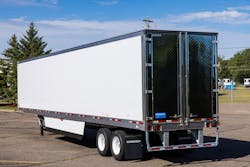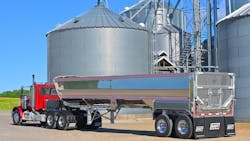Heavy-duty equipment trends of 2023: Trailer Outlook
This is Part 2 of a 3-part series on heavy-duty equipment trends. Read Part 1 here.
In the last piece, we noted how the average number of years before a tractor was replaced reached nearly 9 years. This was due to supply complications stemming the pandemic and overall miles driven coming down, among other reasons. On the trailer side, the American Transportation Research Institute (ATRI) found that the average trade cycle stretched from 12.3 years in 2020 to 15.4 in 2021, excluding flatbeds and intermodal chassis. Those older trailers can only provide adequate service to fleets for so long, though, and 2023 could see a bigger spike in fleets adding new trailers.
“The age of fleets is trending up, and they’re wanting to get those [trailers] replaced,” said Nick Clinkenbeard, product manager of dry and refrigerated vans at trailer manufacturer Wabash.
This has led to strong orders overall. In 2021, trailer orders were just shy of 250,000 units. In October 2022, FTR forecasted this year would hit 303,000 trailer orders, with a 7% increase to 325,000 next year.
Wabash has seen some improvement in delivery over the recent months, Clinkenbeard explained, and the company’s record Q3 revenue of $655.2 million backs that up. The Lafayette, Indiana-based company’s net sales increased 35.8% over Q2, and total backlog was at $2.3 billion as of Sept. 30, up 20% over Q3 2021.
These new trailers are a lot smarter than their replacements, which, at 15+ years, would pre-date the smartphone boom. And now fleets can take advantage of the trailer connectivity increase by spec’ing cargo sensors and trailer telematics devices when they order them.
“With our customers, the data analytics side has grown exponentially over the last few years, and we’re definitely seeing a lot more activity in that space,” Clinkenbeard said. “The way of the future is more connected assets and better visibility to your assets and how they are performing so that you can plan for maintenance rather than have the roadside calls that are costly and disruptive.”
And that data becomes more readily available for maintenance managers to drive data-driven decisions on their maintenance and improve the uptime of their trailers.
Clinkenbeard also noted that fleets’ quest for improved efficiency and uptime means more tire pressure monitoring systems and automatic tire inflation systems, both of which have seen “pretty good adoption” rates from Wabash customers.
Hyundai Translead also holds a positive outlook for 2023 “due to pent-up demand.” It also agrees that smart trailers are the way of the future.
“New technology continues to become more commonplace—there are steady increases across the industry in most items that will help reduce maintenance, increase fuel savings, or provide useful data to a customer operation,” Sean Kenney, chief sales officer at Hyundai Translead, said. “GPS has essentially reached 100% adoption, while accessories that go along with GPS (cargo sensors, door sensors, solar panels) have become a much more common sight in the last two years.”
He added ATIS has seen steady growth, while air disc brakes and TPMS “are also gaining steam and garnering more interest with passing time.”
Because of fuel prices, aerodynamics devices could end up being adopted by “a large majority” of customers, Kenney said.
As far as smart hubs and zero-emission reefer units, these technologies just improve their efficiency rate to become cost-competitive.
“From a fleet perspective, the necessary infrastructure must be in place to utilize new technology and how quickly existing TMS software can manage the new system or environment,” Kenney explained. “It is expected that the use and application of these new technologies will be adapted to the truck/trailer industry in the near future. The time it will take will be decided on whether the needs of both supplier and user are met.
David Giesen, VP of sales for Stoughton Trailers, said shortages from component manufacturers may continue through next year, though.
“The overall industry responded as good as could be expected with all the barriers that were put in place,” he noted. “OEMs are maximizing what they can build given the constraints. Next year looks a lot like the current year.”
Stoughton Trailers has taken measures internally to ensure its trailers last longer for customers. To maximize trailer life and prevent corrosion, Stoughton started galvanizing “almost all painted components,” Giesen said.
East Manufacturing has also experienced longer lead time, according to Chris Cooler, VP of sales and marketing, but that had minimal impact on the customer.
“We have had a few isolated instances where we did not receive materials in time for production causing us to red tag a handful of trailers,” Cooper said. “However, our close relationships with our vendor partners have kept these situations to a bare minimum.”
East has employed proactive measures since the pandemic to ensure it also has the people to assemble the trailers as well. These include labor rate increases, sign-on bonuses, referral bonuses, numerous employee appreciation events, modified pricing strategies, allocations, and more.
“We anticipate that many of these programs will be left in place through 2023,” Cooper said.
Like the rest, Cooper found TPMS and ATIS have been more adopted the past few years, though not at a significant rate. East does predict trailer telematics and other smart trailer technology will “grow dramatically in the coming years,” Cooper added.
About the Author

John Hitch
Editor-in-chief, Fleet Maintenance
John Hitch is the award-winning editor-in-chief of Fleet Maintenance, where his mission is to provide maintenance leaders and technicians with the the latest information on tools, strategies, and best practices to keep their fleets' commercial vehicles moving.
He is based out of Cleveland, Ohio, and has worked in the B2B journalism space for more than a decade. Hitch was previously senior editor for FleetOwner and before that was technology editor for IndustryWeek and and managing editor of New Equipment Digest.
Hitch graduated from Kent State University and was editor of the student magazine The Burr in 2009.
The former sonar technician served honorably aboard the fast-attack submarine USS Oklahoma City (SSN-723), where he participated in counter-drug ops, an under-ice expedition, and other missions he's not allowed to talk about for several more decades.


